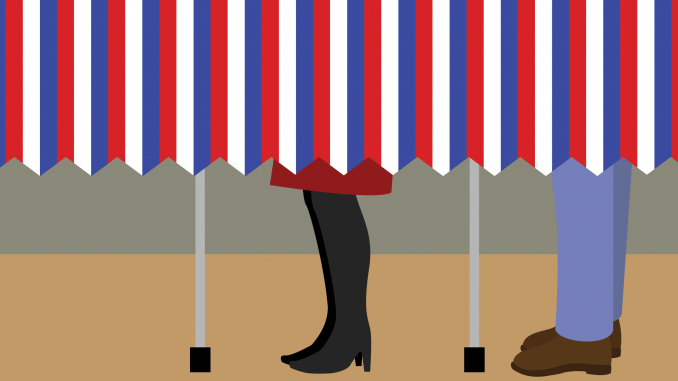
Shakirra Martin, a North Philadelphia resident who lives on 16th Street near Dauphin, described the process of voting in North Philadelphia in two words: “long lines.”
Martin’s experience reflects a 2019 study by the Bipartisan Policy Center that showed that precincts with large minority populations, low incomes and high population density were more likely to experience longer wait times at polling places than precincts that were predominantly white with higher incomes.
The poverty rates in 2017 for the area codes 19121 and 19122, where Temple University is located, are 50.2 percent and 36 percent respectively, according to the United States Census. Despite their longer wait times at polling places, low-income communities tend to have significantly lower voter turnout rates than communities with higher incomes. Econofact, a non-partisan publication that analyzes economic policy, reported only 48 percent of the lowest income bracket voted in the 2016 presidential election, as opposed to 86 percent of the highest income bracket.
Political science professor David Nickerson said cultural norms might explain why low-income areas often have lower voter turnout rates.
“There is less of a norm of voting among peers and neighbors, so there is less pressure to vote,” Nickerson said. “Residents often have less time to vote, and the government often neglects the area so residents feel voting matters less.”
Martin said she thinks the reason people are less likely to vote in low-income neighborhoods is due mostly to the perception that voting is ineffective in creating change.
“I think we [don’t vote] out of attitude,” Martin said. “Like, ‘No, I’m not voting for that person, because they’re not gonna do nothing, they’re not gonna fix up our streets. They’re not gonna do this, they’re not gonna do that, so why vote?’”
Martin also said people in low-income areas may fail to show up at the polls because of an inability to take off of work due to financial circumstances.
“If I’m taking my day off [of work to vote], I could be doing something else, I could be getting money,” Martin added. “I won’t vote for a person that’s not even gonna help me.”
Physical obstacles also exist for low-income individuals on their way to the polls. In the area surrounding Temple, three of the six polling locations available to residents do not offer parking, and only two offer handicap parking, according to Philadelphia Votes’ list of polling places in Philadelphia.
Nickerson said photo ID requirements are an obstacle for low-income communities.
“There are laws championed by Republicans in recent history with the stated goal of improving election security, but have the practical effect of making voting harder,” Nickerson said. “Photo ID requirements and ‘cleaning’ the voter file are good examples of such laws. The effect of these laws are often felt most strongly in poor communities where driver’s licenses are less common.”
Michael Sances, a political science professor, said voter suppression results in low-voter turnout rates in low-income communities.
“The United States has a long and sordid history of political elites designing electoral rules to exclude certain groups from the political process,” Sances said. “The worst of these rules ended with the Voting Rights Act of 1965 and its subsequent enforcement. While the Voting Rights Act has been weakened in recent years, it is still very much in force.”
Nickerson believes the potential for real change lies within the community.
“The most effective thing community leaders can do is leverage the existing talents and energies within the neighborhoods,” Nickerson said. “Recruit block captains to mobilize the people on their block. Recruit charismatic people to run for office and energize the community. Poor communities are often short on time and money, but there are good examples of grassroots campaigns being successful and getting people engaged.”
Martin said she hopes to see an increase in voter engagement in low-income communities.
“Especially in neighborhoods like [North Philadelphia], this is a multiracial neighborhood,” Martin said. “It should be more out here for us.”



Be the first to comment